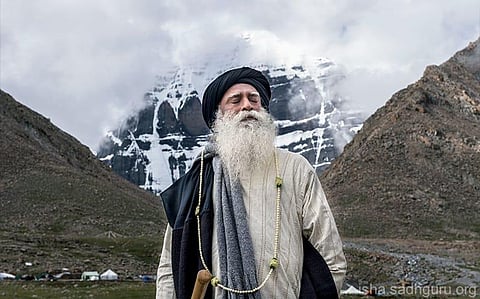
- Home
- न्यूजग्राम
- NewsGram USA
- India
- World
- Politics
- Entertainment
- Culture
- Lifestyle
- Economy
- Sports
- Sp. Coverage
- Misc.
- NewsGram Exclusive
- Jobs / Internships

By Kashish Rai
"Shiva" who is known as Mahadeva is one of the chief deities of Hindus. He is considered as the supreme being within 'Shaivism', one of the major traditions within contemporary Hinduism. He is known as "The Destroyer" within the Trimurti, the Hindu Trinity that includes Brahma and Vishnu.
With context to the Hindu Mythology, Shiva is the supreme being who creates, protects and transforms the Universe~ But Shiva is beyond this identity. Who is Shiva? Is he a god or a construct of collective imagination? Or is there a deeper meaning to Shiva? Revealed only to those who seek? Jaggi Vasudev, an Indian yogi and author popularly known as "Sadhguru" explains it all!
Sadhguru says, "Today, modern science is proving to us that everything comes from nothing and goes back to nothing. The basis of existence and the fundamental quality of the cosmos is vast nothingness. The galaxies are just a small happening – a sprinkling. The rest is all vast empty space, which is referred to as Shiva. That is the womb from which everything is born, and that is the oblivion into which everything is sucked back. Everything comes from Shiva and goes back to Shiva."
"Shiva" who is known as Mahadeva is one of the chief deities of Hindus. He is considered as the supreme being within 'Shaivism', one of the major traditions within contemporary Hinduism. Twitter
Sadhguru also stresses upon the fact that more often Shiva is described as a non-being. He is not described as the light but as darkness. Here, Sadhguru describes that the light is not eternal in comparison to the darkness. He says, "Light is not eternal. It is always a limited possibility because it happens and it ends. Darkness is a much bigger possibility than light. Nothing needs to burn, it is always – it is eternal. Darkness is everywhere. It is the only thing that is all pervading."
Sadhguru tells that in some places in the west, Shiva is considered to be a Demon!
He says that if we look at it as a concept, there isn't a more intelligent concept on the planet about the whole process of creation and how it has happened.
Sadhguru further explains that "Shiva refers to both "that which is not," and Adiyogi, because in many ways, they are synonymous. This being, who is a yogi, and that non-being, which is the basis of the existence, are the same, because to call someone a yogi means he has experienced the existence as himself."
When we talk about Shiva as "that which is not," and Shiva as a yogi, in a way they are synonymous, yet they are two different aspects. Because India is a dialectical culture, we shift from this to that and that to this effortlessly. One moment we talk about Shiva as the ultimate, the next moment we talk about Shiva as the man who gave us this whole process of yoga.
A Still of Adiyogi Statue of Lord Shiva at Coimbatore which is 112.4 ft tall. It has been recognized as the Largest Best Sculpture by the Guinness World Records. The founder of Isha Foundation, Sadhguru Jaggi Vasudev designed the statue and was inaugurated by Honourable PM Sh. Narendra Modi in 2017.
Sadhguru has stressed upon the fact that Shiva is beyond the image and perception of what people see in through Indian Calender art.
He says that, "Calender Artists have made him a chubby-cheeked, blue-colored man because a calendar artist has only one face. Why would a yogi like Shiva look chubby-cheeked? If you showed him skinny it would be okay, but a chubby-cheek Shiva – how is that?"
In the yogic culture, Shiva is not seen as a God. He was a being who walked this land and lived in the Himalayan region. As the very source of the yogic traditions, his contribution in the making of human consciousness is too phenomenal to be ignored.
Sadhguru says that in India since the the Ancient times, temples were built mostly for Shiva. It was only in the last 1000 or so years that other temples came up.
He writes, "The word Shiva literally means 'that which is not.' So the temple was built for 'that which is not.' 'That which is' is physical manifestation; 'that which is not' is that which is beyond the physical."
There are thousands of Shiva temples in the country, and most of them don't have any form as such. They just have a representative form and generally it is a linga.
A Still of Dhyanlinga, a yogic temple near Coimbatore, India. Twitter
"The Adiyogi Shiva does not belong to the past, he belongs to the future"
At many places, Sadhguru has stressed upon this fact that if you read through the Shiva Purana, you cannot identify Shiva as a good person or a bad person. He is Sundaramurthy, the most beautiful. At the same time, nobody can be more horrible than him!
Shiva is a terrible combination of everything put together…
(About Sadhguru: Named one of India's 50 most influential people, Sadhguru is a yogi, mystic, a bestselling author & poet. Sadhguru has been conferred the "Padma Vibhushan" by the Government of India in 2017, the highest amongst the annual civilian awards, accorded for exceptional and distinguished service.)
